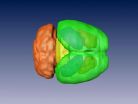(Press-News.org) (Jena) The planet Earth will die – if not before, then when the Sun collapses. This is going to happen in approximately seven billion years. In the universe however the death of suns and planets is an everyday occurance and our solar system partly consists of their remnants.
The end of stars – suns – rich in mass is often a neutron star. These "stars' liches" demonstrate a high density, in which atoms are extremely compressed. Such neutron stars are no bigger than a small town, but heavier than our sun, as physicist PD Dr. Axel Maas of the Jena University (Germany) points out. He adds: "The atomic nuclei are very densely packed." Compared to atoms, like water, the nuclei of neutron stars are as tightly packed as a bus with 1.000 passengers crowded together in comparison to a bus with only the driver on board. In these densely packed atomic nuclei, so-called "nuclear forces" are at work. They keep the neutron star together and are responsible for its "eternal life" – and for the last 35 years the strong nuclear interactions were amongst the greatest challenges of theoretical physics.
Together with colleagues from the Universities of Jena and Darmstadt (both Germany) Axel Maas has succeeded in simulating the strong atomic nuclear interactions to enable its calculability while at the same time preserving the typical characteristics of a neutron star. "It is the first theory for such a tight package," the Jena Physicist says. Previously simulations trying to specify the matter inside of neutron stars collapsed far too much in size and yielded the wrong properties time and again – even on the most powerful computers. "These simulations didn't work because there are too many atomic nuclei," Maas explains the problem, whose solution the world of physics has come closer to due to the calculations of the Jena researchers. To get there, the scientists did so many calculations at the Loewe Center for Science Computing (CSC) in Frankfurt, that it would have taken a single PC approximately 2.500 years to do the same.
"We weren't able to solve the initial problem either," Axel Maas concedes, as algorithms are not (yet) powerful enough. However, the Jena physicist who had been researching this problem since 2007 and his colleagues "reached a new level of quality". They found a "modification of the theory for such a tight package", Maas says. And thus they enabled nuclear material to be simulated. Most characteristics of the neutron star are being preserved with the Jena method, but now they enabled its calculability.
The team accomplished this big step forward by intelligently modifying the nuclear forces and by solving the stacking problem of the atoms. That they were at the same time 'cheating a bit', the physicists freely admit. However, Maas firmly believes: "We found the best possible shortcut". Now they know "what is relevant for the original simulation".
Now this new verifying method is available for numerous questions and theories about neutron stars and very dense atomic nuclei packages. Maas already knows of first groups of scientists who are planning to use the Jena findings to work with them and to carry them further. The scientists involved are already in the process of enlarging the simulation and to verify the results: the results enabling scientists to understand the inside of neutron stars eventually.
INFORMATION:
Original Publication:
Axel Maas, Lorenz von Smekal, Björn Wellegehausen, Andreas Wipf: The phase diagram of a gauge theory with fermionic baryons, Physical Review D 86, 111901 (Rapid Communication) (2012). This article is available for free online: http://arxiv.org/abs/1203.5653
Contact:
PD Dr. Axel Maas
Institute of Theoretical Physics of University of Jena
Max-Wien-Platz 1
D-07743 Jena
Germany
Phone: +49 (0)3641 / 947124
Email: axel.maas[at]uni-jena.de
Cheating to create the perfect simulation
Physicists of the Jena University (Germany) on the way to describe the inside of neutron stars
2013-01-17
ELSE PRESS RELEASES FROM THIS DATE:
Dietary shifts driving up phosphorus use
2013-01-17
Dietary changes since the early 1960s have fueled a sharp increase in the amount of mined phosphorus used to produce the food consumed by the average person over the course of a year, according to a new study led by researchers at McGill University.
Between 1961 and 2007, rising meat consumption and total calorie intake underpinned a 38% increase in the world's per capita "phosphorus footprint," the researchers conclude in a paper published online in Environmental Research Letters.
The findings underscore a significant challenge to efforts to sustainably manage the ...
Viagra converts fat cells
2013-01-17
Researchers from the University of Bonn treated mice with Viagra and made an amazing discovery: The drug converts undesirable white fat cells and could thus potentially melt the unwelcome "spare tire" around the midriff. In addition, the substance also decreases the risk of other complications caused by obesity. The results are now published in "The Journal of the Federation of American Societies for Experimental Biology" (FASEB).
Sildenafil – better known as Viagra – is used to treat erectile dysfunction. This substance prevents degradation of cyclic guanosine mono-phosphate ...
Is athleticism linked to brain size?
2013-01-17
VIDEO:
This movie shows running mice (bred-for-athleticism mouse on the left, regular mouse on the right).
Click here for more information.
RIVERSIDE, Calif. — Is athleticism linked to brain size? To find out, researchers at the University of California, Riverside performed laboratory experiments on house mice and found that mice that have been bred for dozens of generations to be more exercise-loving have larger midbrains than those that have not been selectively bred ...
Fighting sleep: UGA discovery may lead to new treatments for deadly sleeping sickness
2013-01-17
Athens, Ga. – While its common name may make it sound almost whimsical, sleeping sickness, or African trypanosomiasis, is in reality a potentially fatal parasitic infection that has ravaged populations in sub-Saharan Africa for decades, and it continues to infect thousands of people every year.
Few drugs have been developed to treat sleeping sickness since the 1940s, and those still in use are highly toxic, sometimes causing painful side effects and even death. But researchers at the University of Georgia have made a discovery that may soon lead to new therapies for this ...
Critically ill flu patients saved with artificial lung technology treatment
2013-01-17
TORONTO (January 17, 2013 ) - In recent weeks the intensive critical care units at University Health Network's Toronto General Hospital have used Extra Corporeal Lung Support (ECLS) to support five influenza (flu) patients in their recovery from severe respiratory problems.
ECLS systems are normally used at the hospital as a bridge to lung transplantation but increasingly, the hospital is using ECLS on patients where the usual breathing machines (ventilators) cannot support the patient whose lungs need time to rest and heal.
The ECLS systems are essentially artificial ...
Drug abuse impairs sexual performance in men even after rehabilitation
2013-01-17
Researchers at the University of Granada, Spain, and Santo Tomas University in Colombia have found that drug abuse negatively affects sexual performance in men even after years of abstinence. This finding contradicts other studies reporting that men spontaneously recovered their normal sexual performance at three weeks after quitting substance abuse.
The results of this study have been published in the prestigious Journal of Sexual Medicine, the official journal of the International Society for Sexual Medicine. The authors of this paper are Pablo Vallejo Medina –a professor ...
Trading wetlands no longer a deal with the devil
2013-01-17
URBANA – If Faust had been in the business of trading wetlands rather than selling his soul, the devil might be portrayed by the current guidelines for wetland restoration. Research from the University of Illinois recommends a new framework that could make Faustian bargains over wetland restoration sites result in more environmentally positive outcomes.
U of I ecologist Jeffrey Matthews explained that under the current policies if a wetland is scheduled for development and a negative impact is unavoidable, the next option is to offset, or compensate, for the destruction ...
UNC researchers use luminescent mice to track cancer and aging in real-time
2013-01-17
Chapel Hill, NC – In a study published in the January 18 issue of Cell, researchers from the University of North Carolina Lineberger Comprehensive Cancer Center have developed a new method to visualize aging and tumor growth in mice using a gene closely linked to these processes.
Researchers have long known that the gene, p16INK4a (p16), plays a role in aging and cancer suppression by activating an important tumor defense mechanism called 'cellular senescence'. The UNC team led by Norman Sharpless, MD, Wellcome Distinguished Professor of Cancer Research and Deputy Cancer ...
How are middle-aged women affected by burnout?
2013-01-17
New Rochelle, NY, January 17, 2013—Emotional exhaustion and physical and cognitive fatigue are signs of burnout, often caused by prolonged exposure to stress. Burnout can cause negative health effects including poor sleep, depression, anxiety, and cardiovascular and immune disorders. The findings of a 9-year study of burnout in middle-aged working women are reported in an article in Journal of Women's Health, a peer-reviewed publication from Mary Ann Liebert, Inc., publishers. The article is available free on the Journal of Women's Health website at http://www.liebertpub.com/jwh.
In ...
Researchers create method for more sensitive electrochemical sensors
2013-01-17
Graphene and related materials hold promise for the future of electrochemical sensors — detectors that measure the concentration of oxygen, toxic gases, and other substances — but many applications require greater sensitivity at lower detection ranges than scientists have been able to achieve.
A Northwestern University research team and partners in India have recently developed a new method for amplifying signals in graphene oxide-based electrochemical sensors through a process called "magneto-electrochemical immunoassay." The findings could open up a new class of technologies ...
LAST 30 PRESS RELEASES:
Electrodes created using light
Second-hand gift-giving is a well-deliberated decision
How human interaction drove evolution to make bears less aggressive
National Poll: Few parents offer teens guidance on healthy eating during holiday season
Cannabis derivatives could provide new ovarian cancer treatments
Raising strong yeast as a petroleum substitute
Clues to the origin of hot Jupiters hidden in their orbits
Canada’s reduced pledge to Global Fund will impact domestic health
1 in 4 children with major traumatic injuries not cared for in pediatric trauma centres
Duke and Duke-NUS’ joint cross-population research to uncover "East-West" differences in disease and care
Scientists to ‘spy’ on cancer- immune cell interactions using quantum technology breakthrough
Tech savvy users have most digital concerns
Making lighter work of calculating fluid and heat flow
Normalizing blood sugar can halve heart attack risk
Lowering blood sugar cuts heart attack risk in people with prediabetes
Study links genetic variants to risk of blinding eye disease in premature infants
Non-opioid ‘pain sponge’ therapy halts cartilage degeneration and relieves chronic pain
AI can pick up cultural values by mimicking how kids learn
China’s ecological redlines offer fast track to 30 x 30 global conservation goal
Invisible indoor threats: emerging household contaminants and their growing risks to human health
Adding antibody treatment to chemo boosts outcomes for children with rare cancer
Germline pathogenic variants among women without a history of breast cancer
Tanning beds triple melanoma risk, potentially causing broad DNA damage
Unique bond identified as key to viral infection speed
Indoor tanning makes youthful skin much older on a genetic level
Mouse model sheds new light on the causes and potential solutions to human GI problems linked to muscular dystrophy
The Journal of Nuclear Medicine ahead-of-print tip sheet: December 12, 2025
Smarter tools for peering into the microscopic world
Applications open for funding to conduct research in the Kinsey Institute archives
Global measure underestimates the severity of food insecurity
[Press-News.org] Cheating to create the perfect simulationPhysicists of the Jena University (Germany) on the way to describe the inside of neutron stars




